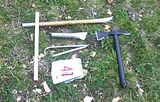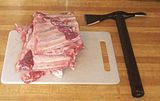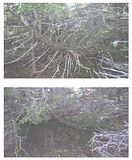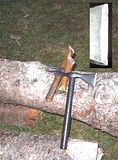
| The review of the VTAC consists of : |

|
From the webpage on the VTAC
The LaGana Tactical Tomahawk (a.k.a. “VTAC”) is the standard by which all other tactical axes are judged, period. Battle proven for over 40 years, Peter LaGana’s axe-head design has served the United States in every major conflict since the Vietnam War. Modernized with 21st century materials and workmanship, the new LaGana Tactical Tomahawk sets the bar for ease of carry, toughness, and versatility. No axe in the War on Terror has seen and done more...
The VTAC made by the American Tomahawk Company is primarily a tactical tomahawk made intended for immediate settlement of interpersonal conflicts. The head is 1060 hardened to 52-54 HRC. The handle is modified nylon, oval cross section with a raised pattern and light finger grooves. The total weight is 530 grams and the overall length is 36 cm. For reference it is slightly longer (by a head width) than the Bruks Wildlife hatchet and significantly lighter (25%). The bevels are are convex and average about 25 degrees per side. The edges all cleanly intersect unlike the Norse tomahawk Cold Steel where the edges actually have flat spots as the bevels don't meet.
 For most kitchen work the VTAC is awkward as the
edge is so far infront of the hand which
makes it difficult to control the blade. It is similar, but more extreme, to
trying to use a cleaver. The use is restricted mainly to chopping and due to
the edge angle being so high on the VTAC,
best suited for very heavy work such as
cutting through thick bones. Cutting meats and such it will work well in making
bulk cuts as these just require a sharp edge and are not as demanding on the
edge cross section and the heavy edge on the VTAC means that a lot of power can
be used to quickly chop apart joints and such without concern.
For most kitchen work the VTAC is awkward as the
edge is so far infront of the hand which
makes it difficult to control the blade. It is similar, but more extreme, to
trying to use a cleaver. The use is restricted mainly to chopping and due to
the edge angle being so high on the VTAC,
best suited for very heavy work such as
cutting through thick bones. Cutting meats and such it will work well in making
bulk cuts as these just require a sharp edge and are not as demanding on the
edge cross section and the heavy edge on the VTAC means that a lot of power can
be used to quickly chop apart joints and such without concern.
The overall cutting ability is similar to heavy tactical knives like the Strider WB which have similar edge geometries and with even just a little use in the kitchen make an obvious point that they were designed for something radically different. Of course, when the edge is properly sharpened it is always possible to make the infamous infomercial "tomato slice". There are some other fruits and vegetables which are also very soft and since they are non-binding then the cross section of the cutting tool really doesn't matter. Moving outside and looking at food from a survival perspective, the spike is handy in digging up roots and tubers and the VTAC easily chops them into pieces for a stew. It also readily chops open hard to cut foods like coconuts and the end spike will readily make a hole to drain out the liquid. On that note the end spike is also useful to make holes in many cans and tins to drain out the liquid and can open them with a series of holes though it is a little time consuming.
 Chopping :
Spending some time with the VTAC and Bruks
Wildlife on some juniper, pine and spruce, the VTAC performed at
50 (5) % of the ability of the Bruks axe in
terms of the number of chops. Since the VTAC is a little lighter, adjusting for
mass would make it about
60 (6) % as efficient per weight. There is no problem with power the performance
limitation simply comes from the edge angle being significantly greater than on
the Bruks. This an be seen directly in the surface of the wood because at times
the wood showed the fibers breaking in the cut. There were also some other
issues like the greater angle on the VTAC meant a higher entry angle had to be
used to reduce glances and there were some security issues with the grip due to
the handle being a little too smooth and the penetration of the blade a little
low. In general as the penetration increases the impact energy is spread over a
longer time and thus there is a reduced collision effect seen by the hand, i.e.,
the tool is more stable and comfortable in hand.
Chopping :
Spending some time with the VTAC and Bruks
Wildlife on some juniper, pine and spruce, the VTAC performed at
50 (5) % of the ability of the Bruks axe in
terms of the number of chops. Since the VTAC is a little lighter, adjusting for
mass would make it about
60 (6) % as efficient per weight. There is no problem with power the performance
limitation simply comes from the edge angle being significantly greater than on
the Bruks. This an be seen directly in the surface of the wood because at times
the wood showed the fibers breaking in the cut. There were also some other
issues like the greater angle on the VTAC meant a higher entry angle had to be
used to reduce glances and there were some security issues with the grip due to
the handle being a little too smooth and the penetration of the blade a little
low. In general as the penetration increases the impact energy is spread over a
longer time and thus there is a reduced collision effect seen by the hand, i.e.,
the tool is more stable and comfortable in hand.
 Shelter :
As the primary ability of the VTAC seemed to be to deliver a lot of power some
time was spent with it working on a small leanto which was fabricated mainly
from a dead tree. The limbs on such wood are very hard and since they are small
they can be very demanding to cut. It is the type of work which usually isn't
done by tools like the Bruks hatchet which is optomized for softer wood. The
VTAC however has enouhg power to break off such wood and the higher edge angle
isn't as much of a drawback as the wood tends to break rather than be cleanly
cut. Using it alongside the
Ratweiler to basically frame out a shelter,
the tomahawk was better
than the knife at clearing the dead wood limbs though the knife was more
efficient at cutting green boughs to fill in the roof and walls. These dead
limbs are also very effective as a source of fuel for a fire as they are very
light and easy to carry and burn very well and give a lot of light and heat.
However they do tend to break and form sharp edges so care needs to be taken
when working with them.
Shelter :
As the primary ability of the VTAC seemed to be to deliver a lot of power some
time was spent with it working on a small leanto which was fabricated mainly
from a dead tree. The limbs on such wood are very hard and since they are small
they can be very demanding to cut. It is the type of work which usually isn't
done by tools like the Bruks hatchet which is optomized for softer wood. The
VTAC however has enouhg power to break off such wood and the higher edge angle
isn't as much of a drawback as the wood tends to break rather than be cleanly
cut. Using it alongside the
Ratweiler to basically frame out a shelter,
the tomahawk was better
than the knife at clearing the dead wood limbs though the knife was more
efficient at cutting green boughs to fill in the roof and walls. These dead
limbs are also very effective as a source of fuel for a fire as they are very
light and easy to carry and burn very well and give a lot of light and heat.
However they do tend to break and form sharp edges so care needs to be taken
when working with them.
|
Making a small fire, the VTAC gathers the dry limbs well just as it did when
making the shelter. However the Ratweiler did
better at making shavings and cutting the lighter vegetation for tinder as well
as limbing the boughs to get the fire going to get the dry wood to burn. Some
work with the sharpened under edge on the VTAC showed that there is potential
there for brush cutting if it was reground to a more acute profile, it would
function similar to a scythe.
THe VTAK did have one advatnage over the knife for fire making in extreme circumstances as cutting larger logs is often of value in rain. On larger woods long blades have penetration issues as more of the blade comes in contact with the wood. The VTAC still gets the same regardless penetration on wood as large as or larger than the bit width (assuming the wood is of similar density) and thus the relative performance over long blades increases on thicker woods. A large fairly rotted log like the one shown on the right tends to absorb rain and thus can protect coals and keep the fire going. The coals will also of course keep boiling the water out of the log and thus it isn't unusual to keep a coal bed over night even in significant rain. |

|

|
Spike : the main advantage of a spike is penetration, the ability to blast a hole quickly through difficult to cut materials. It goes through steel belted tires for example and easily puts holes in heavy metal. It also readily breaks up hardened ground, which if too rocky or frozen is difficult to work with a digging stick.
 The VTAC is readily filed and the edge was reground during the
first significant sharpening to see how the tomahawk would work more as focused
bushcraft tool with a more acute edge. After about 10 minutes the shoulder of
the bevel was reduced at 14 degrees and it swept up to 18 in the last 0.050".
This is within a few degrees of optimal for most wood types. With the new edge
geometry, cutting down a few small trees had much less impact as the blade
penetrated further, pretty much all elements of performance increased. Less
chops to take down the tree (performance increased about 50%), more comfortable
in hand and less turning. It also easily clipped off the small boughs which it
didn't do well before.
The VTAC is readily filed and the edge was reground during the
first significant sharpening to see how the tomahawk would work more as focused
bushcraft tool with a more acute edge. After about 10 minutes the shoulder of
the bevel was reduced at 14 degrees and it swept up to 18 in the last 0.050".
This is within a few degrees of optimal for most wood types. With the new edge
geometry, cutting down a few small trees had much less impact as the blade
penetrated further, pretty much all elements of performance increased. Less
chops to take down the tree (performance increased about 50%), more comfortable
in hand and less turning. It also easily clipped off the small boughs which it
didn't do well before.
 The increase in
cutting ability was also evident with shaping a wedge as before
it basically would chop them to
shape but now had much more ability to
carve them to refine the shape. In general such wood carving tends to be
inversely proportional to angle so if you half the angle you double the carving
ability which was about the case here. This tends to have even more of an
increase in extended use due to fatigue effects and thus just a short session of
filing really made a large effect on the ability of the tomahawk to work as a
bushcraft tool.
Of course the more acute edge does have durability issues, repeating the
same metal cutting as before, the edge took visible damage immediately.
About 0.1 mm or so deep, easily visible up close, but hard to
make out at arms length. However the concrete chopping impacted the edge
significantly with each impact and after just a few chops parts of the
edge were impacted up to about 0.75 mm deep.
The upper part of the edge as shown on the right was used on the concrete and the bottom on
the metal cutting.
The increase in
cutting ability was also evident with shaping a wedge as before
it basically would chop them to
shape but now had much more ability to
carve them to refine the shape. In general such wood carving tends to be
inversely proportional to angle so if you half the angle you double the carving
ability which was about the case here. This tends to have even more of an
increase in extended use due to fatigue effects and thus just a short session of
filing really made a large effect on the ability of the tomahawk to work as a
bushcraft tool.
Of course the more acute edge does have durability issues, repeating the
same metal cutting as before, the edge took visible damage immediately.
About 0.1 mm or so deep, easily visible up close, but hard to
make out at arms length. However the concrete chopping impacted the edge
significantly with each impact and after just a few chops parts of the
edge were impacted up to about 0.75 mm deep.
The upper part of the edge as shown on the right was used on the concrete and the bottom on
the metal cutting.
 The nylon sheath has a plastic liner. The straps on the back have a velco
overlay so it can be removed from belt attachment without removing the belt or
the attachment can go underneath a further set of loops have no velcro closure
for a more secure attachment. The tomahawk has multiple rigging points and is
designed for tactical carry. One possible issue is that it does rattle in the
sheath when carried and the metal on hard plastic is fairly noisy. This can be
solved by lining the plastic with a dense fabric.
The nylon sheath has a plastic liner. The straps on the back have a velco
overlay so it can be removed from belt attachment without removing the belt or
the attachment can go underneath a further set of loops have no velcro closure
for a more secure attachment. The tomahawk has multiple rigging points and is
designed for tactical carry. One possible issue is that it does rattle in the
sheath when carried and the metal on hard plastic is fairly noisy. This can be
solved by lining the plastic with a dense fabric.
 The VTAC grip is designed with a significant focus for throwing and thus it has
to have a fairly smooth release and this conflicts with grip aspects which
would increase performance for brush work as the two are in opposition on
aspects such taper. Tomahawks tend to have fairly straight handles without
extensive end hooks whereas axes will commonly have a pommel or a significant
swell and this enhances the ability of the grip to transfer power on the swing,
however it would interfer with the ability to smoothly release the axe if
thrown. Thus there are some issues with the VTAC grip as seen in brush work as
it will tend to turn more readily in hand when chopping on a poor impact and it
tends to in general move around a little. Both of these can be reduced with use
of proper grip tape. The picture at the right shows one variant of the tomahawk
grip which presents the underhook edge for use as a draw knife. The ergonomics
are solid in that grip though the angle could be reduced to enhance the wood
carving ability.
The VTAC grip is designed with a significant focus for throwing and thus it has
to have a fairly smooth release and this conflicts with grip aspects which
would increase performance for brush work as the two are in opposition on
aspects such taper. Tomahawks tend to have fairly straight handles without
extensive end hooks whereas axes will commonly have a pommel or a significant
swell and this enhances the ability of the grip to transfer power on the swing,
however it would interfer with the ability to smoothly release the axe if
thrown. Thus there are some issues with the VTAC grip as seen in brush work as
it will tend to turn more readily in hand when chopping on a poor impact and it
tends to in general move around a little. Both of these can be reduced with use
of proper grip tape. The picture at the right shows one variant of the tomahawk
grip which presents the underhook edge for use as a draw knife. The ergonomics
are solid in that grip though the angle could be reduced to enhance the wood
carving ability.
The VTAC proved itself to be a very durable tomahawk for cutting metals and concrete and suffered little damage. The spike was also capable of penetrating thick materials like steel belted tires with ease and tore into rocky soil readily. As a brush tool its performance was fairly low when compared to an axe so focused such as the Bruks Wildlife however it still would offer significant increase in functionality if added to a smaller knife. With just a little work with a file the wood working ability takes a major jump forward and it was now in a similar class as wood working hatchets in several respects.
Comments can be emailed to cliffstamp@[REMOVE]cutleryscience.com and made to the following :
More information can be obtained at the ATC website.
| Last updated : | 8 : 20 : 2007 |
| Originally written: | 11 : 20 : 2006 |